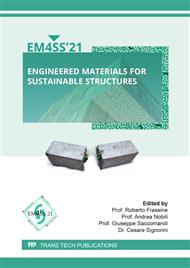[1]
E. Schmidl, S. Hinrichs, Geocycle Provides Sustainable Recycling of Rotor Blades in Cement Plant, DEWI MAGAZIN NO. 36, February 2010, 6-14.
Google Scholar
[2]
S.J. Pickering, Recycling technologies for thermoset composite materials—current status, Composites Part A: Applied Science and Manufacturing, Volume 37, Issue 8, (2006) 1206-1215. https://doi.org/10.1016/j.compositesa.2005.05.030.
DOI: 10.1016/j.compositesa.2005.05.030
Google Scholar
[3]
A. D. La Rosa, S. Greco, C. Tosto, G. Cicala. LCA and LCC of a chemical recycling process of waste CF-thermoset composites for the production of novel CF-thermoplastic composites. Open loop and closed loop scenarios, Journal of Cleaner Production, Volume 304, (2021), 127158, https://doi.org/10.1016/j.jclepro.2021.127158.
DOI: 10.1016/j.jclepro.2021.127158
Google Scholar
[4]
P. Asokan, M. Osmani, A.D.F. Price, Assessing the recycling potential of glass fibre reinforced plastic waste in concrete and cement composites, Journal of Cleaner Production 17 (2009) 821–829A.
DOI: 10.1016/j.jclepro.2008.12.004
Google Scholar
[5]
A. Yazdanbakhsh and L.C. Bank, A Critical Review of Research on Reuse of Mechanically Recycled FRP Production and End-of-Life Waste for Construction, Polymers 6 (2014) 1810-1826;.
DOI: 10.3390/polym6061810
Google Scholar
[6]
C. Brazão Farinha, J. de Brito, R. Veiga, Assessment of glass fibre reinforced polymer waste reuse as filler in mortars, Journal of Cleaner Production, 210 (2019) 1579-1594. doi.org/10.1016/j.jclepro.2018.11.080.
DOI: 10.1016/j.jclepro.2018.11.080
Google Scholar
[7]
A.J. Nagle, E.L. Delaney, L.C. Bank, P.G. Leahy, A Comparative Life Cycle Assessment between landfilling and Co-Processing of waste from decommissioned Irish wind turbine blades, Journal of Cleaner Production, 277 (2020) 123321, https://doi.org/10.1016/j.jclepro.2020.123321.
DOI: 10.1016/j.jclepro.2020.123321
Google Scholar
[8]
AD La Rosa, LCA of biopolymers in: Biopolymers and Biotech Admixtures for Eco-efficient Construction Materials, Woodhead Publishing Series, 12, 2016, Pages 57-78.
DOI: 10.1016/b978-0-08-100214-8.00004-x
Google Scholar
[9]
ISO (International Organization for Standardization), 2006a. 14040 – Environmental Management - Life Cycle Assessment - Principles and Framework.
Google Scholar
[10]
ISO (International Organization for Standardization), 2006b. 14044- Environmental Management - Life Cycle Assessment - Requirements and Guidelines.
Google Scholar
[11]
A. D. La Rosa, I.Blanco, D. R. Banatao, S. J. Pastine, A. Björklund, G. Cicala. Innovative Chemical Process for Recycling Thermosets Cured with Recyclamines® by Converting BioEpoxy Composites in Reusable Thermoplastic—An LCA Study. Materials, 11 (2018) 353.
DOI: 10.3390/ma11030353
Google Scholar
[12]
L.P. Mikkelsen, A simplified model predicting the weight of the load carrying beam in a wind turbine blade, IOP Conf. Ser.: Mater. Sci. Eng. 139 (2016) 012038.
DOI: 10.1088/1757-899x/139/1/012038
Google Scholar
[13]
J.P. Blasques, M. Stolpe, Multi-material topology optimization of laminated composite beam cross sections, Compos. Struct. 94 (2012) 3278-3289.
DOI: 10.1016/j.compstruct.2012.05.002
Google Scholar
[14]
F. Bensadoun, K.A.M. Vallons, L.B. Lessard, I. Verpoest, A.W. Van Vuure, Fatigue behaviour assessment of flax–epoxy composites, Compos. Part A Appl. Sci. Manuf. 82 (2016) 252-266.
DOI: 10.1016/j.compositesa.2015.11.003
Google Scholar
[15]
J.M. Rinker, M.H. Hansen, T.J. Larsen, Calibrating a wind turbine model using diverse datasets, J. Phys.: Conf. Ser. 1037 (2018) 062026.
DOI: 10.1088/1742-6596/1037/6/062026
Google Scholar


